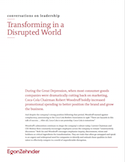Transforming in a Disrupted World
During the Great Depression, when most consumer goods companies were dramatically cutting back on marketing, Coca-Cola Chairman Robert Woodruff boldly increased promotional spending to better position the brand and grow the business.
And despite the company’s strong position following that period, Woodruff warned against complacency, announcing to the Coca-Cola Bottlers Association in 1936: “There are hazards in this talk of success. ... After all, Coca-Cola is not yesterday. Coca-Cola is tomorrow.”
Woodruff’s admonition continues to shape the company’s culture today. Current Chairman and CEO Muhtar Kent constantly encourages employees across the company to remain “constructively discontent.” Both his and Woodruff’s messages emphasize inquiry, discernment, vision and boldness as critical ingredients for transformation. They are traits that often go untapped and speak to an urgent and widespread need for companies to identify and unleash those qualities in their talent to effectively compete in a world of unpredictable disruption.
The challenges of the legacy organization
More and more companies are waking up to find themselves in the midst of a rapidly changing environment. New entrants are continuously emerging across geographies to dislodge incumbents. Streams of data are multiplying exponentially to confound executives on what the customer wants. Despite the strategic imperatives of agility and focus as the world unpredictably shifts around them, many legacy organizations struggle with transformation. They hire chief digital officers, develop intricate strategic planning documents and launch social media campaigns, yet these initiatives are often unable to meaningfully change individual and collective behavior and values.
Why is this so frequently the case? In our view, the problem is that most organizations—and certainly most organizations established before the digital era—simply were not created to be the fast-moving, highly adaptive enterprises that today’s economy demands. Instead, they were designed to generate a reliable stream of incremental improvements, which were aggressive enough to stay at pace or even ahead of their defined market.
During the postwar period, “continuous improvement” was a genuinely successful business strategy. How people lived and the way business was conducted changed very little from 1945 through the 1990s. There were significant regulatory, cultural and geographic barriers to entry, forcing markets and competitors to be regional or national in scope. Leading companies typically owned proprietary advantages such as physical assets, intellectual property or business systems, and success came from refining the product or service year after year. This strategy called for and was reinforced by a common style of leadership. Hierarchical in nature, it mirrored the command-and-control style of the military and sports. With a focus on doing the same process better and/or faster, the workforce reflected this style with a few “commanders” atop an “army” of hard-working team players.
Today, leaders must be able to learn and adapt, solve problems quickly and in new ways, and have the fortitude to accept and overcome failure in order to effectively evaluate and react to the onslaught of data and marketplace changes. With strategies, systems and leadership styles firmly entrenched in traditional organizations, this type of adaptation seems daunting at best and futile at worst. We believe, however, that traditional organizations can succeed in transforming themselves. It begins with the recognition that fundamental changes are required in the way companies develop their greatest asset for this kind of transformation: their people. Identifying, developing and using each individual’s inherent leadership potential can change a culture and unleash new possibilities for each person and the company as a whole.
Identifying potential for transformation
There are three important questions that companies embarking on transformation must ask themselves:
- Are we assessing our talent’s potential for learning and growth and, if so, how?
- How are we developing our talent to maximize their leadership potential?
- Does our culture cultivate the kind of leadership potential we need to compete, not just today but also tomorrow?
Using a robust system to identify and assess potential will unlock the answers to these questions. Through research and observation of thousands of senior executives around the world over the past decade, we have identified several traits that underlie an executive’s facility to develop and grow as a leader over time. These factors are critical in understanding an individual’s ability to grow into the type of leader needed to drive the transformation required in today’s organization. The model identifies and characterizes innate traits, described below, that transcend industries, roles and business contexts*:
- Curiosity: Is driven to proactively seek understanding and new learning through gaining fresh ideas, varied experiences and the latest information. This insatiable curiosity also means that he/she actively works on personal development. High curiosity often is the major differentiator of a person possessing high potential.
- Insight: Processes a vast range and amount of information from many kinds of sources and uses this information to shape insights that make sense of ambiguity, simplify complexity and break the status quo.
- Engagement: Connects with people because he/she resonates with their motivations, priorities and logic. Enthusiasm, energy and sense of purpose are infectious; engages the hearts and minds of others to deliver shared objectives and mutual benefits.
- Determination: Enjoys a challenge, overcomes obstacles and willingly takes on higher risk opportunities with ingenuity and tenacity.
While not necessarily an indicator of near-term promotion readiness, the potential model predicts which capabilities will be easier and more natural for an executive to develop and provides a view of how much responsibility he or she could take on over time.
Assessing potential is a critical step organizations should take in order to understand how far their talent can develop and whether an individual’s ability to adapt and grow aligns with the company’s transformation objectives.
*Egon Zehnder’s potential model is validated and proprietary.
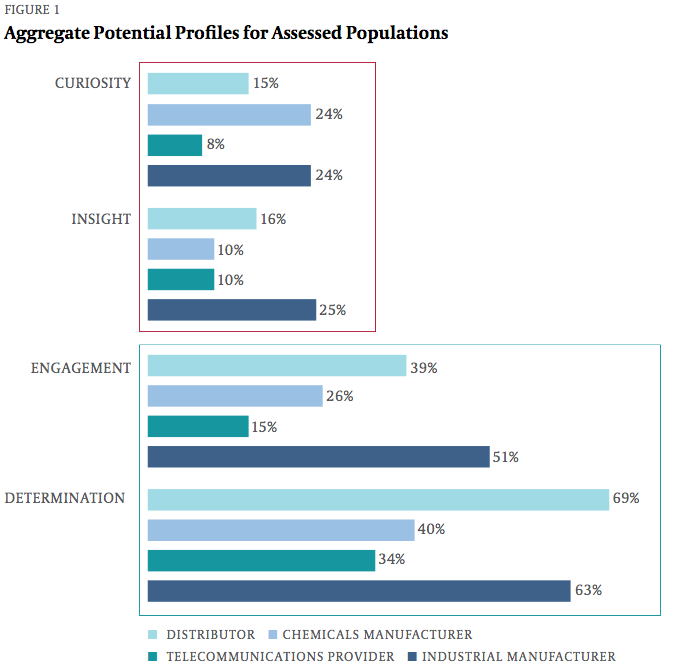
Potential profiles in traditional vs. transformative organizations
Organizations need various combinations of traits at different times. In traditional organizations, we have observed there commonly is an overemphasis on rewarding and promoting executives with a high level of determination and engagement. These executives tend to be both customer focused and results oriented. They are at ease building relationships, which makes them a natural team leader and collaborator. These people tend to be well-known and liked across the company, as well as championed for their ability to firefight.
The data in Figure 1 are derived from four recent Egon Zehnder assessment engagements. The percentages show the portion of assessed participants with strength in each element of potential. In all cases, talent spikes markedly in determination and/or engagement but is relatively deficient in curiosity and insight.
What is missing from these organizations is the critical mix for disruption and transformation: curiosity and insight. Such people excel at learning and synthesizing information, developing and testing hypotheses, and generating novel ideas. They are comfortable wading through unchartered territory to create new categories and deliver services in unique ways. If they also are determined, they will work smarter – not just harder. If they are people oriented, their insight will make them more effective in driving change. Perhaps most important, curious individuals want to learn about themselves. They ask for feedback and seek opportunities to grow and apply their learning to improve themselves and the business. While determination and engagement are important, individuals who lack curiosity and insight are better suited to operating than innovating.
A group president confronted with the message that his organization is populated primarily by hard- working team players concluded, “Given how fast things are changing, we urgently need much more curiosity to take advantage of digital opportunities and to remain a leader in our industry.”
Developing talent to fully realize potential
Even if a company has a talent pool that is well-balanced across the elements of potential, this is no guarantee that the organization is developing its potential fully. Experiences shape who we are, and without the right cadence and mix of experiences, raw potential may not materialize into the set of leadership behaviors a company requires.
For example, many traditional organizations lack an effective job rotation program, so most executives default to a random career path or remain in the same function or business unit for many years, which has several consequences:
- Employees end up in jobs that don’t leverage the areas where these individuals have the most potential, stunting their growth and diluting their contributions.
- Curiosity is not sparked and, in fact, can diminish from a lack of different and challenging experiences.
- Companies don’t develop enough enterprise leaders. As a result, the succession bench is jeopardized.
This often means when a company is in need of a new general manager or business unit leader, it is a challenge to find candidates who have had the required breadth of experience and resulting capabilities. It also can mean that when a company needs innovative thinking in a functional area like information technology or marketing, it is a challenge to find qualified candidates who bring fresh perspectives from other parts of the business. Companies can accelerate the development of high-potential leaders through rotations designed to maximize exposure to varied functions, business units and geographies, a strategy that will produce holistic thinkers and well-rounded leaders. A study conducted by Egon Zehnder showed that stretch assignments and job rotation—not formal training— were the greatest contributors to executives realizing their potential (see Figure 2). Unfortunately, in a recent survey of 500 companies on 37 key talent practices, job rotation was rated as being executed the poorest.**
**Source: Driving Performance Through Talent Management, Executive Program, Harvard Business School, May 2016.
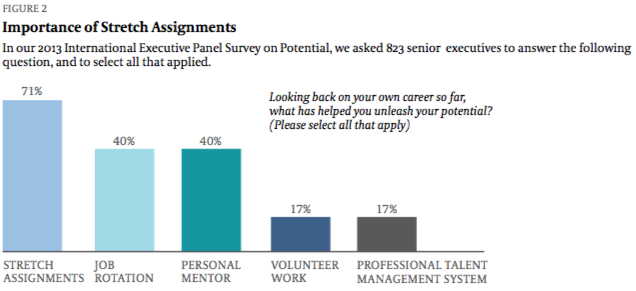
General Mills is a good example of a company that is strategically developing talent to optimize potential. The organization has prioritized international experience as critical to its talent and, ultimately, to its success in the marketplace. Half the workforce is from outside the United States, and half has experience working in a country outside one’s home country. While investing in building local teams, the company rotates expatriates to circulate global expertise and create adaptable leaders. Cross-border experience, in particular, is critical here because it taps into determination, engagement, curiosity and insight, creating better collaborators, team leaders and change leaders.
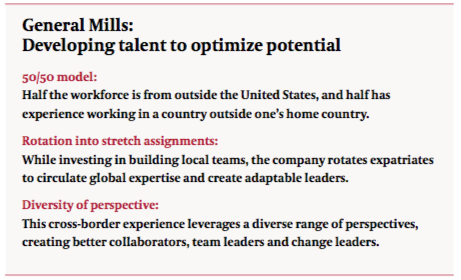
Create a culture that cultivates and reinforces transformation
While traditional organizations may have people who are just as creative and innovative as disruptive enterprises, the culture of traditional organizations, many times, is not well-suited to recognizing, using or rewarding what these people bring to the table. For example, in organizations that value results and relationships more than idea generation and experimentation, a person’s determination and engagement will be rewarded and validated, whereas curiosity and insight may be overlooked or, worse, misunderstood. Unless leadership creates a culture that makes room for diverse thinkers, legacy organizations will marginalize the people they view as non-conformists. If an individual has a high level of curiosity and insight but does not have a high level of determination, he/she may come across as “never able to get anything done.” If an individual does not have a high level of engagement, he/she may be perceived as “unable to navigate the system.” Such biases can influence performance reviews, promotions and assignments, leaving the potential of people with high curiosity and insight untapped. In such an inhospitable environment, these people frequently choose to leave the organization or, over time, stop demonstrating those behaviors altogether. Unlike commanding an army, “falling in line” should be discouraged. Meetings where everyone has the chance to speak will be undeniably richer. Understanding how people on teams think and learn best will help get the most out of employees and empower them to push the limits of the organization.
The goal should be to have a healthy mix of traits represented, a culture that supports expression, and a talent management system that adequately utilizes and develops individuals.
Case Study:
A Global Manufacturer Restructures its Technology Organization
Egon Zehnder recently partnered with a global manufacturer restructuring its technology function. Unlike the organizations described earlier, many of the executives we met here were both curious and insightful, but those traits were not fully evident in their competencies. For example, highly curious and insightful leaders did not have strong strategic capabilities, but, rather, they possessed capabilities typically emphasized in traditional organizations such as results orientation.
It became clear that the executives were not in an environment where they could thrive and maximize their full potential. One executive shared, “We have an ‘answers’ culture, not a ‘questions’ culture.” This is the kind of intangible barrier that will limit the realization of potential no matter how much raw material exists.
The chart below shows that relative to the market, the group assessed had strength in results orientation, which would be expected given the high level of determination, though relative weakness in strategic orientation despite having strong curiosity and insight.
From this, we can see that the natural energy of this group of leaders was both untapped and undervalued. It is important for a company to know the potential mix of its talent and how to channel it to maximize the contributions of individuals and teams.
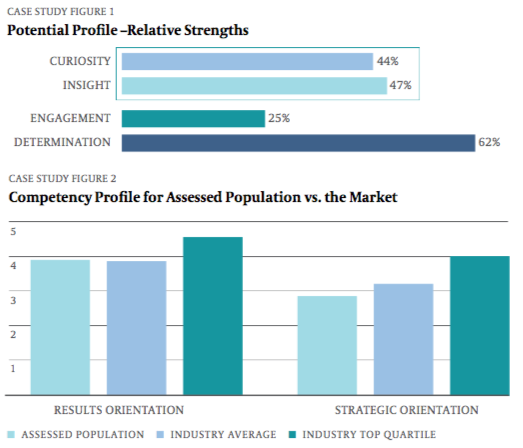
Take action before it is too late
There is no time to waste in creating an organization with the ability to constantly transform and innovate in a continuously evolving environment. Based on our recent experience working with mature companies across a wide range of industries, we recommend the following actions:
Assess for potential. Use a holistic approach to accurately assess the potential of your talent. Knowing an individual’s potential allows you to tap into his or her energy source, stretch natural strengths further and understand one’s growth mindset, as well as focus the organization’s development resources on those employees with the most potential. You also will better understand gaps in your succession pipeline, which you can work to fill before the need for a change arises.
Load up on curiosity and insight. Insatiable curiosity about what is around the corner is paramount to staying ahead of the competition and capturing the next breakthrough idea. With a greatly increased flow of information, executives at all levels must be able to quickly develop perspectives and take decisive action. A group of hard-working team players following orders from above is not good enough anymore.
Hire from a wide range of backgrounds. Diversity of experience increases the range of perspectives in an organization, which is imperative when evaluating new situations and developing creative solutions. For many companies, this will require a deliberate rethinking of where and how the organization recruits talent at all levels. Organizations that historically have promoted the majority of their leaders from within the company should consider whether a controlled but continuous flow of talent from other companies and industries can boost curiosity as a way to increase innovation and transformation.
Rotate high-potential executives. A company-wide job rotation program will create leaders with multifaceted perspectives who are able to adapt quickly to new challenges. Cadence is important— keep talent moving throughout the organization to avoid pockets of stagnation from developing, though don’t move people before they have had a chance to live with the results of their strategy and actions. Senior leadership must make people development and succession planning a top priority for every leader—or talent will not be shared, and the wheels of job rotation will grind to a halt.
Create a culture that encourages debate and experimentation. No matter the range of viewpoints around the table, they cannot be harnessed without the necessary space and support for new ideas to flourish and take hold. Leaders accustomed to making unilateral decisions and shepherding teams from point to point will need to empower their teams in order to realize the best path forward.
In conclusion: Thriving in a constant state of disruption
Building an organization with the ability to continuously transform and capitalize on the rapidly changing marketplace often will be the difference between dominating your industry or being overtaken by a more agile competitor. The choice is yours to remake your approach to organizational development in this newly disrupted world.






